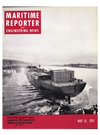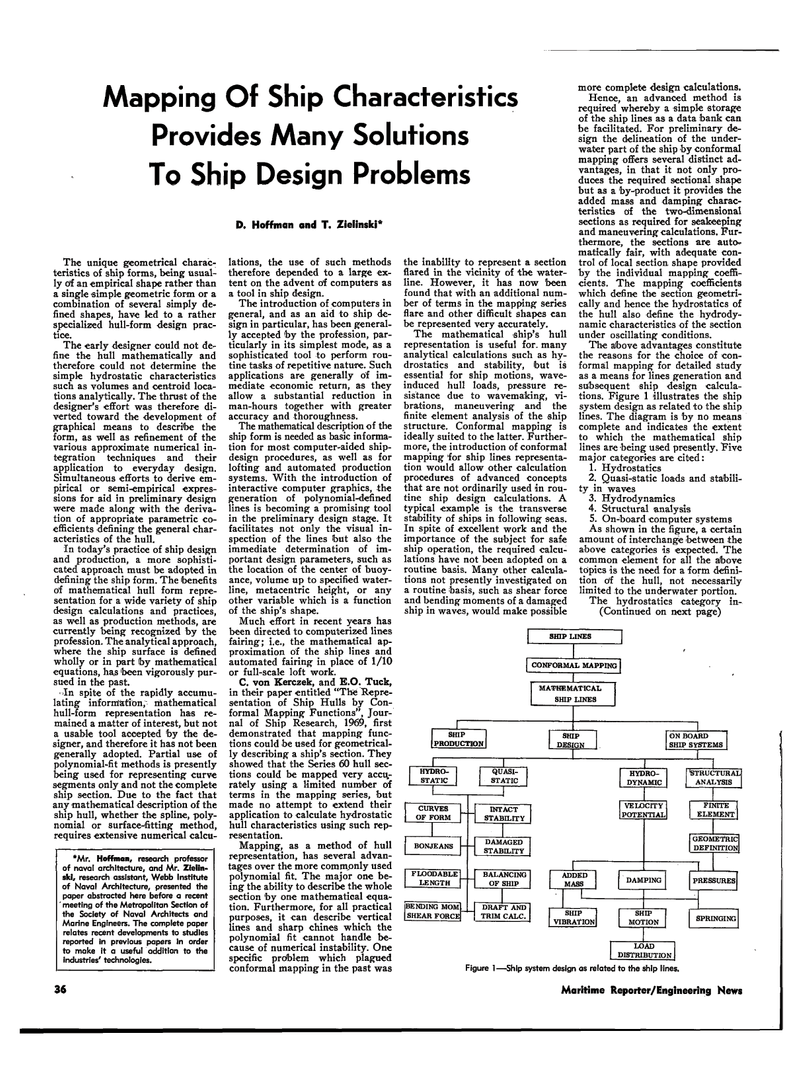
Page 35: of Maritime Reporter Magazine (May 15, 1974)
Read this page in Pdf, Flash or Html5 edition of May 15, 1974 Maritime Reporter Magazine
Mapping Of Ship Characteristics
Provides Many Solutions
To Ship Design Problems
The unique geometrical charac- teristics of ship forms, being usual- ly of an empirical shape rather than a single simple geometric form or a combination of several simply de- fined shapes, have led to a rather specialized hull-form design prac- tice.
The early designer could not de- fine the hull mathematically and therefore could not determine the simple hydrostatic characteristics such as volumes and centroid loca- tions analytically. The thrust of the designer's effort was therefore di- verted toward the development of graphical means to describe the form, as well as refinement of the various approximate numerical in- tegration techniques and their application to everyday design.
Simultaneous efforts to derive em- pirical or semi-empirical expres- sions for aid in preliminary design were made along with the deriva- tion of appropriate parametric co- efficients defining the general char- acteristics of the hull.
In today's practice of ship design and production, a more sophisti- cated approach must be adopted in defining the ship form. The benefits of mathematical hull form repre- sentation for a wide variety of ship design calculations and practices, as well as production methods, are currently being recognized by the profession. The analytical approach, where the ship surface is defined wholly or in part toy mathematical equations, hajs 'been vigorously pur- sued in the past.
In spite of the rapidly accumu- lating information, mathematical hull-form representation has re- mained a matter of interest, but not a usable tool accepted by the de- signer, and therefore it has not been generally adopted. Partial use of polynomial-fit methods is presently being used for representing curve segments only and not the complete ship section. Due to the fact that any mathematical description of the ship hull, whether the spline, poly- nomial or surface-fitting method, requires extensive numerical calcu- *Mr. Hoffman, research professor of naval architecture, and Mr. Zielin- ski, research assistant, Webb Institute of Naval Architecture, presented the paper abstracted here before a recent ' meeting of the Metropolitan Section of the Society of Naval Architects and
Marine Engineers. The complete paper relates recent developments to studies reported in previous papers in order to make it a useful addition to the industries' technologies.
D. Hoffman and T. Zielinski* lations, the use of such methods therefore depended to a large ex- tent on the advent of computers as a tool in ship design.
The introduction of computers in general, and as an aid to ship de- sign in particular, has been general- ly accepted by the profession, par- ticularly in its simplest mode, as a sophisticated tool to perform rou- tine tasks of repetitive nature. Such applications are generally of im- mediate economic return, as they allow a substantial reduction in man-hours together with greater accuracy and thoroughness.
The mathematical description of the ship form is needed as basic informa- tion for most computer-aided ship- design procedures, as well as for lofting and automated production systems. With the introduction of interactive computer graphics, the generation of polynomial-defined lines is becoming a promising tool in the preliminary design stage. It facilitates not only the visual in- spection of the lines but also the immediate determination of im- portant design parameters, such as the location of the center of buoy- ance, volume up to specified water- line, metacentric height, or any other variable which is a function of the ship's shape.
Much effort in recent years has been directed to computerized lines fairing; i.e., the mathematical ap- proximation of the ship lines and automated fairing in place of 1/10 or full-scale loft work.
C. von Kerczek, and E.O. Tuck, in their paper entitled "The Repre- sentation of Ship Hulls by Con- formal Mapping Functions", Jour- nal of Ship Research, 1969, first demonstrated that mapping func- tions could be used for geometrical- ly describing a ship's section. They showed that the Series 60 hull sec- tions could be mapped very accu- rately using a limited number of terms in the mapping series, but made no attempt to extend their application to calculate hydrostatic hull characteristics using such rep- resentation.
Mapping, as a method of hull representation, has several advan- tages over the more commonly used polynomial fit. The major one be- ing the ability to describe the whole section 'by one mathematical equa- tion. Furthermore, for all practical purposes, it can describe vertical lines and sharp chines which the polynomial fit cannot handle be- cause of numerical instability. One specific problem which plagued conformal mapping in the past was the inability to represent a section flared in the vicinity of the water- line. However, it has now been found that with an additional num- ber of terms in the mapping series flare and other difficult shapes can be represented very accurately.
The mathematical ship's hull representation is useful for. many analytical calculations such as hy- drostatics and stability, but is essential for ship motions, wave- induced hull loads, pressure re- sistance due to wavemaking, vi- brations, maneuvering and the finite element analysis of the ship structure. Conformal mapping is ideally suited to the latter. Further- more, the introduction of conformal mapping for ship lines representa- tion would allow other calculation procedures of advanced concepts that are not ordinarily used in rou- tine ship design calculations. A typical example is the transverse stability of ships in following seas.
In spite of excellent work and the importance of the subject for safe ship operation, the required calcu- lations have not been adopted on a routine basis. Many other calcula- tions not presently investigated on a routine basis, such as shear force and bending moments of a damaged ship in waves, would make possible more complete design calculations.
Hence, an advanced method is required whereby a simple storage of the ship lines as a data bank can be facilitated. For preliminary de- sign the delineation of the under- water part of the ship by conformal mapping offers several distinct ad- vantages, in that it not only pro- duces the required sectional shape but as a by-product it provides the added mass and damping charac- teristics cff the two-dimensional sections as required for seakeeping and maneuvering calculations. Fur- thermore, the sections are auto- matically fair, with adequate con- trol of local section shape provided by the individual mapping coeffi- cients. The mapping coefficients which define the section geometri- cally and hence the hydrostatics of the hull also define the hydrody- namic characteristics of the section under oscillating conditions.
The aJbove advantages constitute the reasons for the choice of con- formal mapping for detailed study as a means for lines generation and subsequent ship design calcula- tions. Figure 1 'illustrates the ship system design as related to the ship lines. The diagram is by no mea.ns complete and indicates the extent to which the mathematical ship lines are being used presently. Five major categories are cited: 1. Hydrostatics 2. Quasi-static loads and stabili- ty in waves 3. Hydrodynamics 4. Structural analysis 5. On-board computer systems
As shown in the figure, a certain amount of interchange 'between the above categories is expected. The common element for all the above topics is the need for a form defini- tion o'f the hull, not necessarily limited to the underwater portion.
The hydrostatics category in- (Continued on next page)
Figure 1—Ship system design as related to the ship lines.
ADDED
MASS
SHIP
VIBRATION 36 Maritime Reporter/Engineering Hews

 34
34

 36
36
